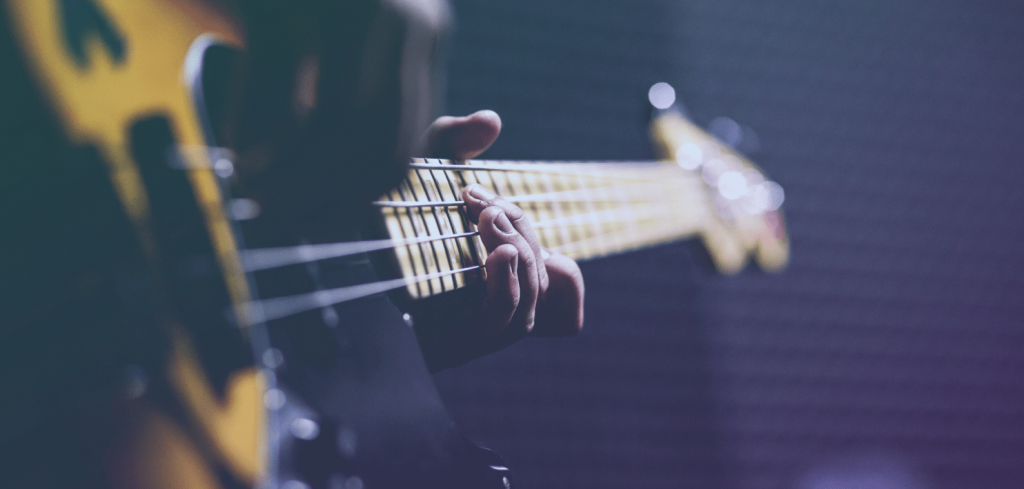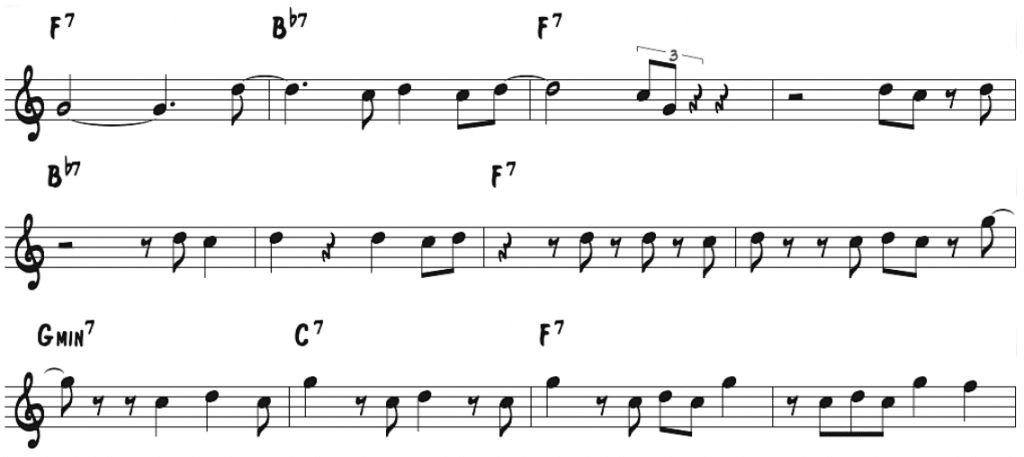How creative are you each time you play your instrument? Think about it for a second…are you actually creating new musical ideas in your solos? Are you actually free when you improvise??
As a creative improvising musicians, this is one question that we should all ask ourselves from time to time.
It’s well known that hours of repetition, memorization, and imitation are the groundwork for learning improvisation. But there’s a catch! This essential practice process doesn’t naturally lend itself to free, spontaneous thinking.
In fact, with all this repetition it’s quite easy to get boxed into the safe confines of our daily routine. The same tunes, the same language, even the same practice schedule.
As a result, we often fall back on our “musical crutches” and rely on other musicians when playing within a group. The drummer will keep the time, the pianist will play the changes, the horn player has the melody, and someone else will keep track of the form, right?
We get away with not using our ears, with not counting or knowing the form, with “kind of” knowing the changes, and with relying on our trusty licks to get us through a solo.
Rarely do we hold ourselves responsible for each and every aspect of the music.
But this doesn’t mean that we can’t change things. Here are four exercises to reinforce your musical skills and bring the creativity & freedom back into your playing…
I. Improvise with melodic or harmonic restrictions
When we improvise, one thing that we have an abundance of are possibilities. I mean options seem like a good thing, right?
However, when we’re confronted with unlimited possibilities, we inevitably revert going to revert to what’s safe. We fall back on what we know, the stuff that we’ve practiced hundreds of times in the practice room.
This is not necessarily a bad thing when you’re going for proficiency, but when your goal is creativity, this can be a problem.
To perform in the moment and interact with other musicians, not to simply saunter on stage and rehash the lines that you’ve already played at home.
If you find that you are continuously overwhelmed by the harmonic and rhythmic options that you have as a soloist, simply limit your choices. Pick only one interval, one rhythm, or one harmonic concept to improvise with.
Try it with the Blues. Pick a rhythm, interval, or chord tone and develop a solo from this singular musical idea. A great example of this technique is the opening to Sam Newsome’s solo on Au Privave:
He creates an entire chorus of music with just 3 notes. You could do the same with more complex tunes like Giant Steps or Moment’s Notice, where the tendency is to fall back on licks and patterns.
When you have only one rhythm or one interval to work with you are forced to be much more creative, and chances are you’re going to play something that you haven’t rehearsed.
You’ll quickly find that restricting your options will yield a fresh breath of creativity to your stale old lines.
Solo Free Improvisation
Despite how creative and spontaneous we try to be when we play over chord progression, we rarely “improvise” in the actual sense of the the word.
We use memorized lines, patterns, and transcribed language that we’ve practiced thousands of times. We shape our solos and use harmonic “crutches” to navigate these familiar progressions.
But how often do we actually improvise and play ideas that we’ve never played before?
To truly be totally creative you need to develop a completely different set of skills. You need to break out of that mental box and start improvising freely. Using the ideas above, start with a single idea – an interval, a melodic direction, a rhythm, a repeated note, or a mental image – and create an entire solo based off of this concept.
There are no rules here. You don’t have to follow a chord progression, you don’t have to play in time, and best of all, you can’t mess up. Simply open your mind and let the music guide you.
Check out this video of Mark Turner improvising freely using this concept:
Give this a try in the practice room. You could start with a major triad or arpeggio, an interval, a rhythm, or a even small melodic fragment. Start slowly and see how you can develop and expand upon this idea.
II. Duo Improvisation
Sometimes the creative spark that we need as an improviser falters when we are by ourselves. It can seem like we are at a dead end and can’t come up with any new ideas to play; same old tunes, same old licks, same annoying play-a-long track.
When you find yourself in this situation, remember that music and improvisation is a group effort. We need to share ideas and inspire each other to move forward.
If you’re stuck in the practice room, get out and find some other musicians to play with. Within minutes of playing with someone else, you will find numerous musical ideas from that shared creative energy.
Duo Improvisation over a tune
This is easy. Find another musician on any instrument, pick a tune, time signature, or form and start playing. Try to go back and forth, at times making statements and at others reacting and accompanying.
Pick musicians that force you out of your comfort zone and make you think in a new way. For example, as a horn player I like to play duo with a drummer or even another horn player.
With a drummer, I am totally responsible for the melodic and harmonic aspects of the tune because there is no bass player to cover the form and no piano player to comp the changes.
Likewise, when I play with another horn player we both become responsible for the time and form, something that is not usually expected of us.
You hear duo performances all the time and playing in this setting can push you to improve your musicianship and creativity. Check out this duo of Trane playing the tune Four with someone tapping out rhythms on what sounds like a table on this bootleg recording…
Free Duo Improvisation
Just as you can improvise freely by yourself, you can improvise freely with another player.
This type of playing can be extremely beneficial for your creativity and musical freedom. Not only do you have to create melodies and rhythms out of thin air, you have to listen to and react to someone else doing the same.
Listen to George Garzone and Joe Lovano demonstrating this concept:
III. Play free with a group
Do you find with your group that you play the same tunes the same way every time you perform? Or, maybe you’re having trouble connecting as a group, developing a cohesive time-feel, or taking chances and really improvising together.
The solution may not be more rehearsal, but rather an exercise that forces you to listen and actually create and interact with the players around you. Instead of running the same tunes over and over again, try something completely different – have everyone improvise freely.
No music, no form, no set time or chord progression, just improvisation and listening.
I’m not talking about a messy out of control free for all, but a musical performance. Strive for all of the elements of musicality that you’d have when you’d perform a written piece of music: theme, variation, dynamics, counterpoint, rhythmic interest, etc.
This is definitely an exercise that is easier said than done and it will take some time to become good at it. You have to learn to really work together, to listen to each other, and to support each other musically.
It may be confusing and frustrating at first, but after some practice, you’ll notice that the group is actually listening to each other and creating together on an entirely new level.
Take a listen to Lennie Tristano’s group using the concept of free group improvisation on the tune Intuition:
As you can hear, this type of playing requires the up most musicianship, a far cry from a harmonic and rhythmic free-for-all devoid of any musicality. A more modern example of this is from Nicholas Payton’s album Nick @ Night:
IV. Play tunes and improvise by yourself
If you truly want to be free as an improviser, you must be responsible for every aspect of the music. You need to keep the time, know the form and melody, and be responsible for the chord progression.
Don’t be the bass player that doesn’t know the melody, the horn player that can’t keep track of the time, or the drummer that can’t hear a chord progression. As a musician you are responsible for every aspect of the music, even if you don’t normally play that part.
You must be a complete musician, but if you keep following the same patterns in the practice room and on gigs, you’re headed for trouble.
A simple way to find out very quickly where you stand musically is to perform a tune by yourself. No rhythm section to hold the tune together and no horn players to play the melody; it all falls on you.
Many of the best improvisers today practice and often perform tunes by themselves. Take a listen to a few examples:
Chris Potter on It Could Happen to You:
Seamus Blake playing Body and Soul:
Just because you don’t play a harmonic instrument doesn’t mean that you can’t play and improvise tunes by yourself. Check out this surprisingly melodic version of Ari Hoenig playing Anthropology. You can hear a fragment of the melody at the beginning of the video and the melody returns loud and clear at the end (1:38).
Tapping into your creativity every day
All of these concepts will not only make you a more free and creative improviser, they will raise your overall level of musicianship.
The ability to create something out of nothing is necessary for the improvising musician. In every performance we need to take chances, we need to react to the other players, and we need to let the music happen by itself.
Improvising music out of thin air is not easy to do. Even though you may not realize it, these skills are necessary for any performance that you may do.
What would you do if the pianist or guitarist dropped out when you were soloing? Could you keep it together?
What if the rest of the group dropped out on a tune, could you keep the form and time going? In situations like this, it’s sink or swim and these exercises will help you to keep your head above water.
To give you some inspiration, here’s one of the most creative and free groups to play this music, Miles Davis’ quintet with Wayne Shorter, Herbie Hancock, Ron Carter, and Tony Williams.
Listen to the quintet playing Madness from the incredible 1967 recording Nefertiti. You hear freedom, creativity, and daring. There is a form, but there is also spontaneity. Time, but no changes.
This recording has all the hallmarks of great musicianship and instrumental technique, but without the willingness to create something profoundly original and truly in the moment, this music would not be possible.












